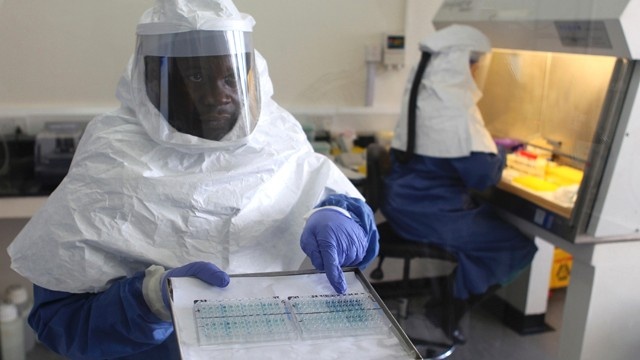
Both vaccines essentially consist of a harmless virus that has been "spiked" with a protein from the Ebola virus, said Derek Gatherer, a bioinformatics researcher at Lancaster University in the United Kingdom who studies viral genetics and evolution.
If a person is given the vaccine, "the body thinks it's being infected with this rather innocuous virus, [and] part of the virus happens to be the Ebola protein," said Gatherer, who is not involved in work on the Ebola vaccines. This prompts an immune response, and the body develops antibodies against the Ebola protein, Gatherer said. [How Do People Survive Ebola?]
Ideally, if a vaccinated person were later exposed to the real Ebola virus, these antibodies would be ready to fight off the infection before it could take hold.
Comment: Yes, wishful thinking at its best. There are several reasons why this might NOT be such a good idea:
1) If the vaccine fails - and vaccines have a solid track record of failure - those who were used as guinea pigs would be predisposed to infection.
2) A vaccine may exert selective pressure on the virus to produce "mutants" capable of being more pathogenic. See a perfect example here: Fail: Infant Hep B vaccines perform shamefully; time to end them? See also:
- Vaccine not virus responsible for Spanish flu
- Children Who Get Flu Vaccine Have Three Times Risk Of Hospitalization For Flu, Study Suggests.
4) Mother nature doesn't need our help to create a deadly mutated virus: New Light on the Black Death: The Viral and Cosmic Connection.
5) With so many factors at stake here, Ebola's air-borne transmission might become more aggressive in the near future. A nasal vaccine sounds like the kind of thing which might help in that regard.
The first vaccine, which began safety testing this summer, is being developed by the National Institute of Allergy and Infectious Diseases (NIAID) and GlaxoSmithKline. It consists of a type of cold virus called an adenovirus that affects chimpanzees and has genetic material from two strains of Ebola: Zaire Ebola (which is causing the current outbreak in West Africa) and Sudan Ebola, according to NIAID.
The engineered adenovirus can't replicate in the human body. It's used to deliver the Ebola gene to a person's cells, which, in turn, produce a single Ebola protein. If the vaccine works as it should, this protein will cause an immune response. But in any case, it cannot cause Ebola virus disease, according to the NIAID.
The first test of the vaccine in people, called a Phase 1 trial, includes 20 healthy adults who will be injected with one of two doses of the vaccine.
The second vaccine, called VSV-ZEBOV, consists of a virus that mainly infects animals (including rodents, cattle, swine and horses), called the vesicular stomatitis virus (VSV). In the vaccine, one gene of VSV has been replaced with the gene for the outer protein of the Zaire Ebola virus, according to the National Institutes of Health.
Safety testing of the VSV-ZEBOV vaccine began this month at the NIH, the agency said. The study involves 39 healthy adults who will be given either a low dose of the vaccine, a higher dose of the vaccine or a placebo. VSV-ZEBOV was developed by the Public Health Agency of Canada and was licensed to the biopharmaceutical company NewLink Genetics Corp.
Results of the safety trials are expected by December, and the second round of trials will begin in people in West Africa shortly thereafter, according to the World Health Organization. (The second round of testing is known as Phase 2 trials, which will further test vaccines' safety, and also look at its effectiveness.)
If the vaccines are effective, pharmaceutical companies could manufacture several hundred thousand doses in the first half of 2015, and millions of doses by the end of that year, WHO said.



Comment: Do you really trust a company with such a history of fraud and bribery with your life? If you are not aware already, you may want to read up on the dangers of vaccines:
- Polish study: No historical benefit in vaccines
- 20 facts about vaccines you won't likely see on a government website
- Vaccines Are Causing Mutations That May Jeopardize The Health of Future Generations
- Vaccines Found to Cause Diabetes in Children
Also, isn't it interesting that pharmaceutical companies are busily "reinventing the wheel" while multiple experimental Ebola vaccines already exist? An "arms race" for profits?